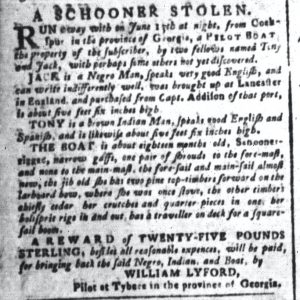Who was the subject of an advertisment in a colonial American newspaper 250 years ago today?

“RUN away … JACK is a Negro Man … TONY is a brown Indian Man.”
The July 4, 1770, edition of the South-Carolina and American General Gazette include an advertisement that advised readers of “A SCHOONER STOLEN” and the two enslaved men responsible for absconding with it. Although the advertisement asserted that Jack, “a Negro Man,” and Tony, “a brown Indian Man,” had “RUN away … with perhaps some others not yet discovered,” it actually told a truncated story of enslaved men who liberated themselves. Such advertisements had been a regular feature of colonial American newspapers since the Boston News-Letter commenced publication in 1704. Enslaved people had been liberating themselves long before that.
According to William Lyford, Jack and Tony stole his “PILOT BOAT” and made their escape “from Cockspur in the province of Georgia.” To help readers identify the two men, Lyford noted their heights and also reported that Tony spoke “good English and Spanish,” while Jack spoke “very good English, and can write indifferently well,” a skill that he might have planned to put to use in evading capture. Lyford also indicated that Jack “was brought up at Lancaster inEngland, and purchased from Capt. Addison of that port.” He did not insert other details about the two men, but instead provided an extensive description of the boat before offering a reward “for bringing back the said Negro, Indian, and Boat.”
This advertisement tells a story of disobedience and disorder from the perspective of an enslaver for the consumption of others that he hoped would assist in perpetuating slavery even if they did not themselves hold others in bondage. Lyford, like so many other enslavers, sought to use the power of the press to encourage and direct surveillance of Black and Indigenous men. His descriptions of Jack and Tony also served as instructions for scrutinizing all Black and Indigenous men to determine whether they were the enslaved men who had stolen the pilot boat and made their escape. Lyford attempted to frame Jack and Tony’s actions as unruly and dangerous, but their rebelliousness did not neatly fit within that narrative. In making their escape, appropriating Lyford’s boat for that purpose, Jack and Tony engaged in a powerful act of resistance. They liberated themselves. Despite Lyford’s best efforts to set the terms, he could not deprive Jack and Tony of the agency they exerted in pursuing their own destiny. Contrary to his intentions, Lyford’s advertisement resonates as a memorial to the courage of Jack and Tony and a truncated narrative of their resistance.
Jack and Tony liberated themselves while the colonies were in the middle of the imperial crisis that culminated in the American Revolution and independence for the United States. White colonists lamented their figurative enslavement to Parliament, all while literally enslaving Black and Indigenous people. Yet enslaved people understood the value of freedom and self-determination long before the upheaval between Britain and the colonies; they did not require the philosophizing of white colonists to recognize the injustices imposed upon them. Thousands of newspaper advertisements for “runaways,” for enslaved people who liberated themselves, published throughout the colonies before and during the era of the American Revolution demonstrate that was the case.
In 1770, colonists did not know that July 4 would become such an important date. It was not yet known as Independence Day, but it was a day of independence for Jack and Tony, just as it was for other enslaved people who liberated themselves, some of them documented in newspaper advertisements. Since the inception of the Slavery Adverts 250 Project, the Adverts 250 Project has featured advertisements about enslaved people who liberated themselves on July 4, both in celebration of their acts of resistance and as a reminder of the tension between liberty and enslavement that was the paradox of the American founding. In addition to the story of Jack and Tony in 1770, read more about the story of Caesar in 1767, the story of Harry, Peg, and their two children in 1769, and the story of Guy and Limehouse in 1769. They all made their own declarations of independence when they liberated themselves from their enslavers.
